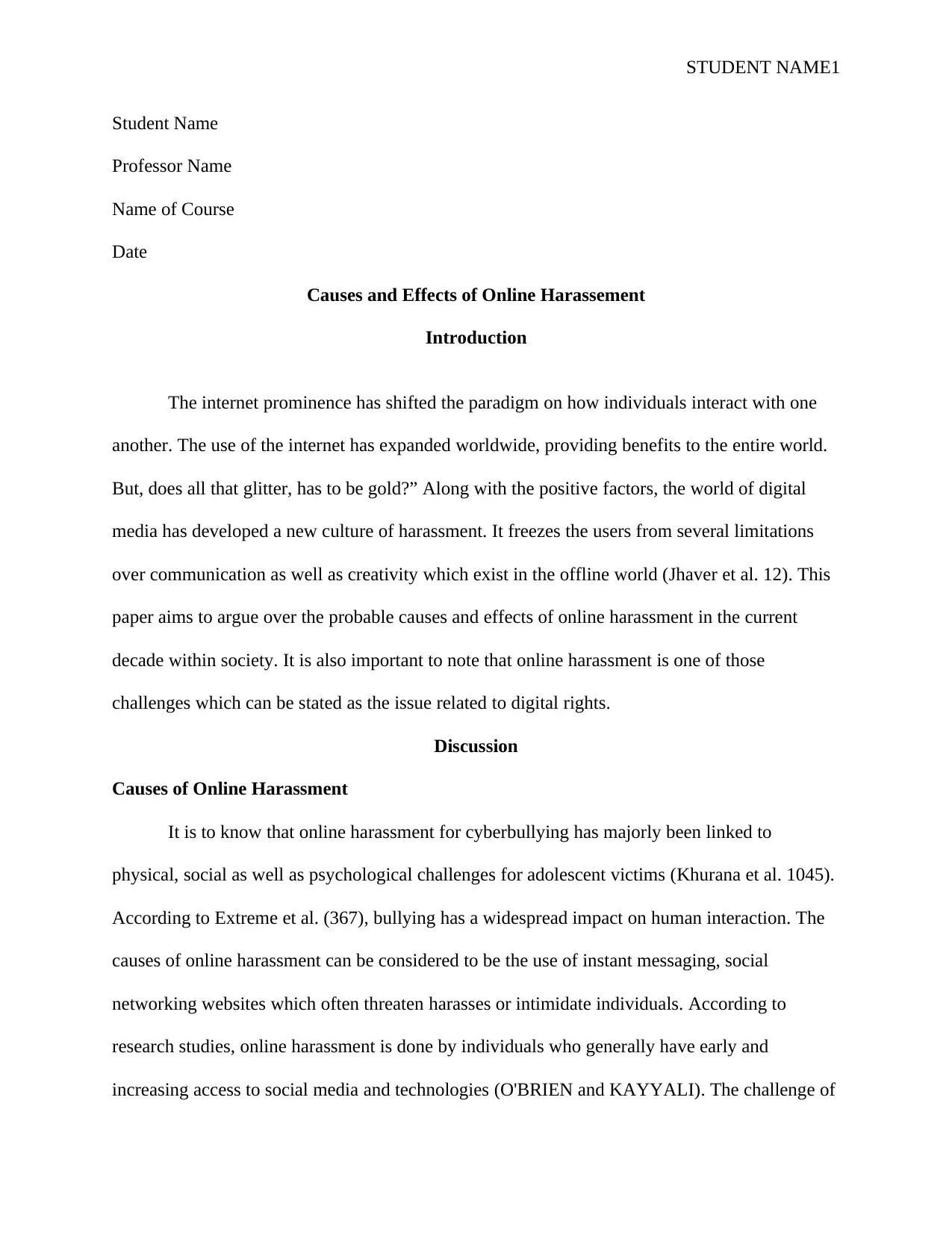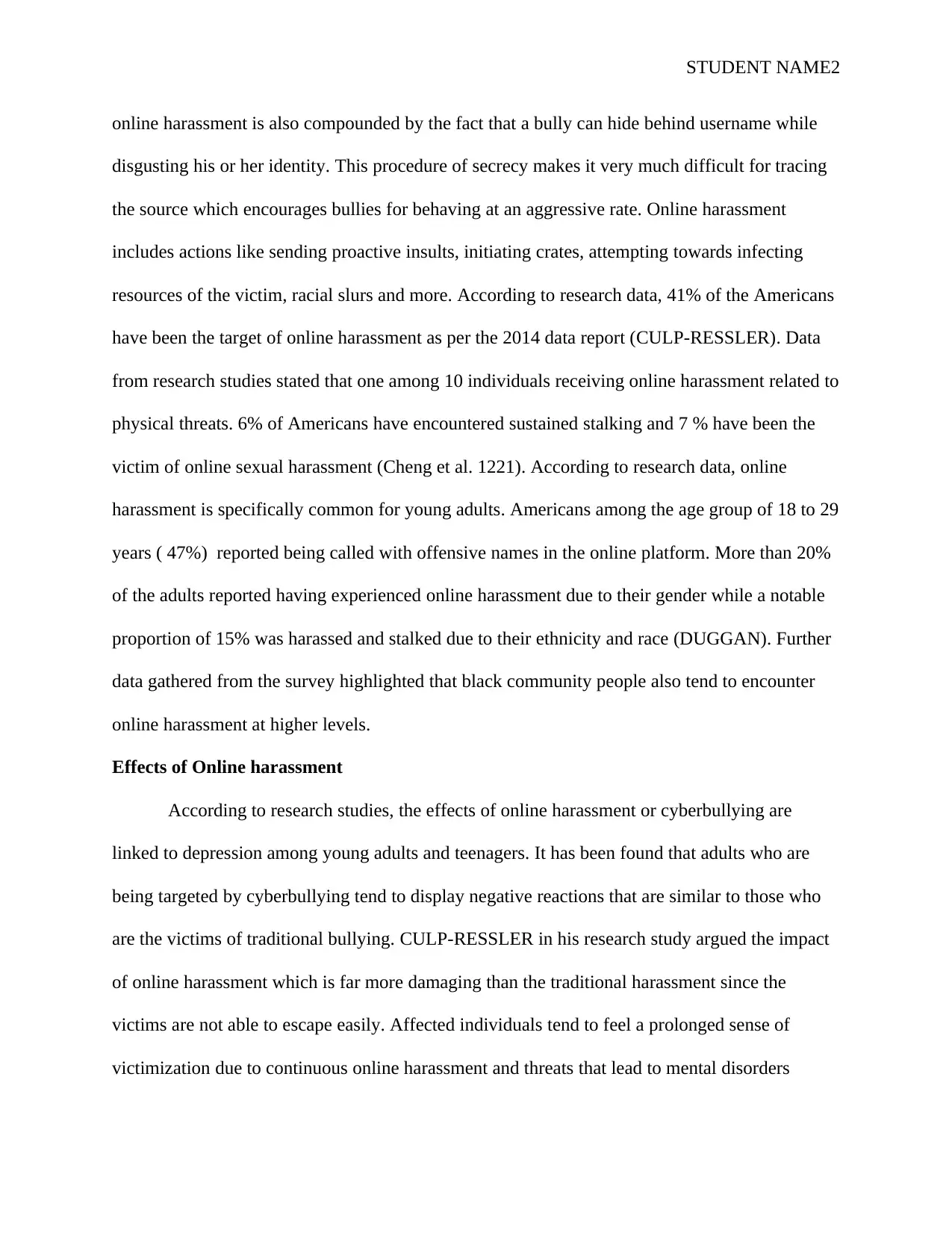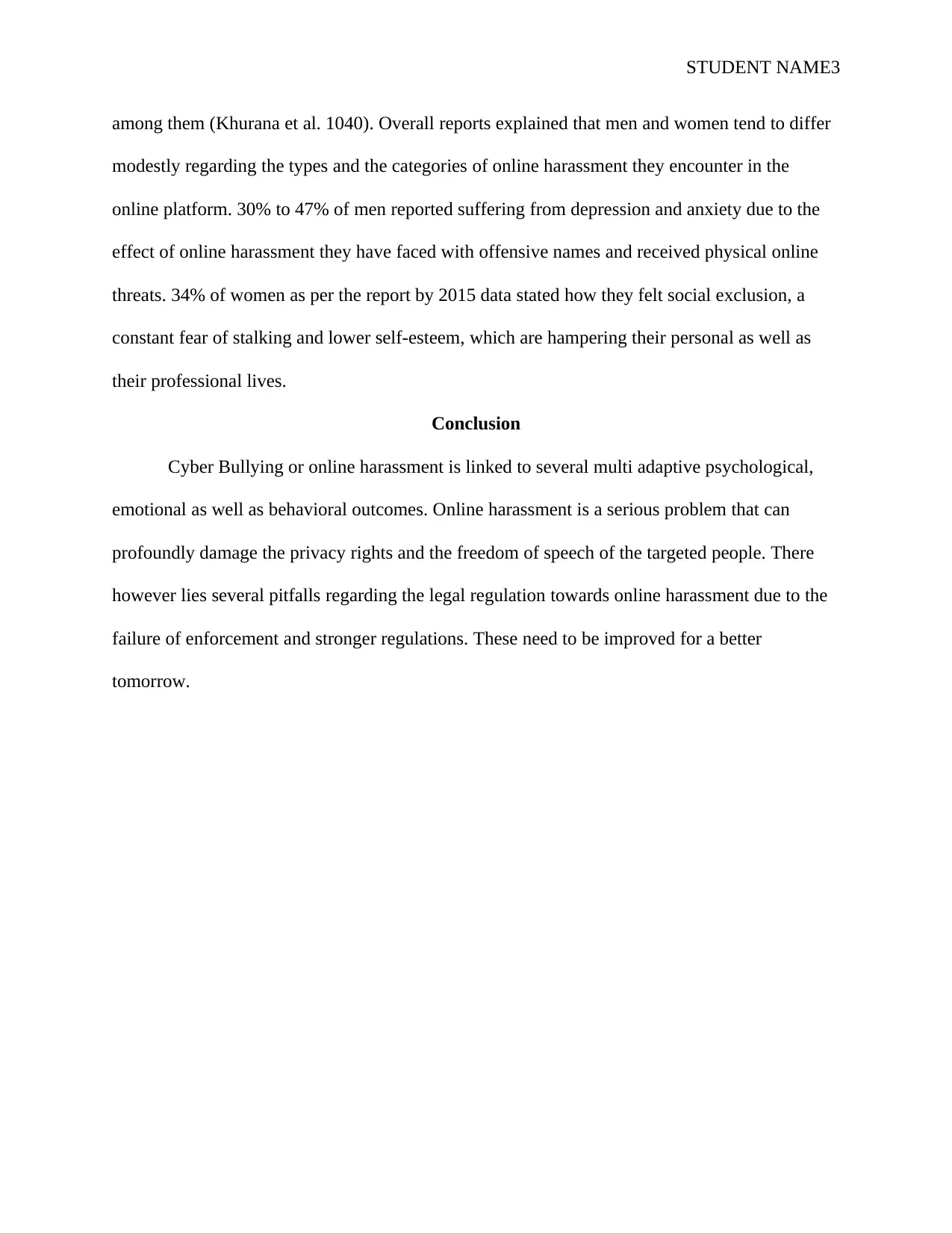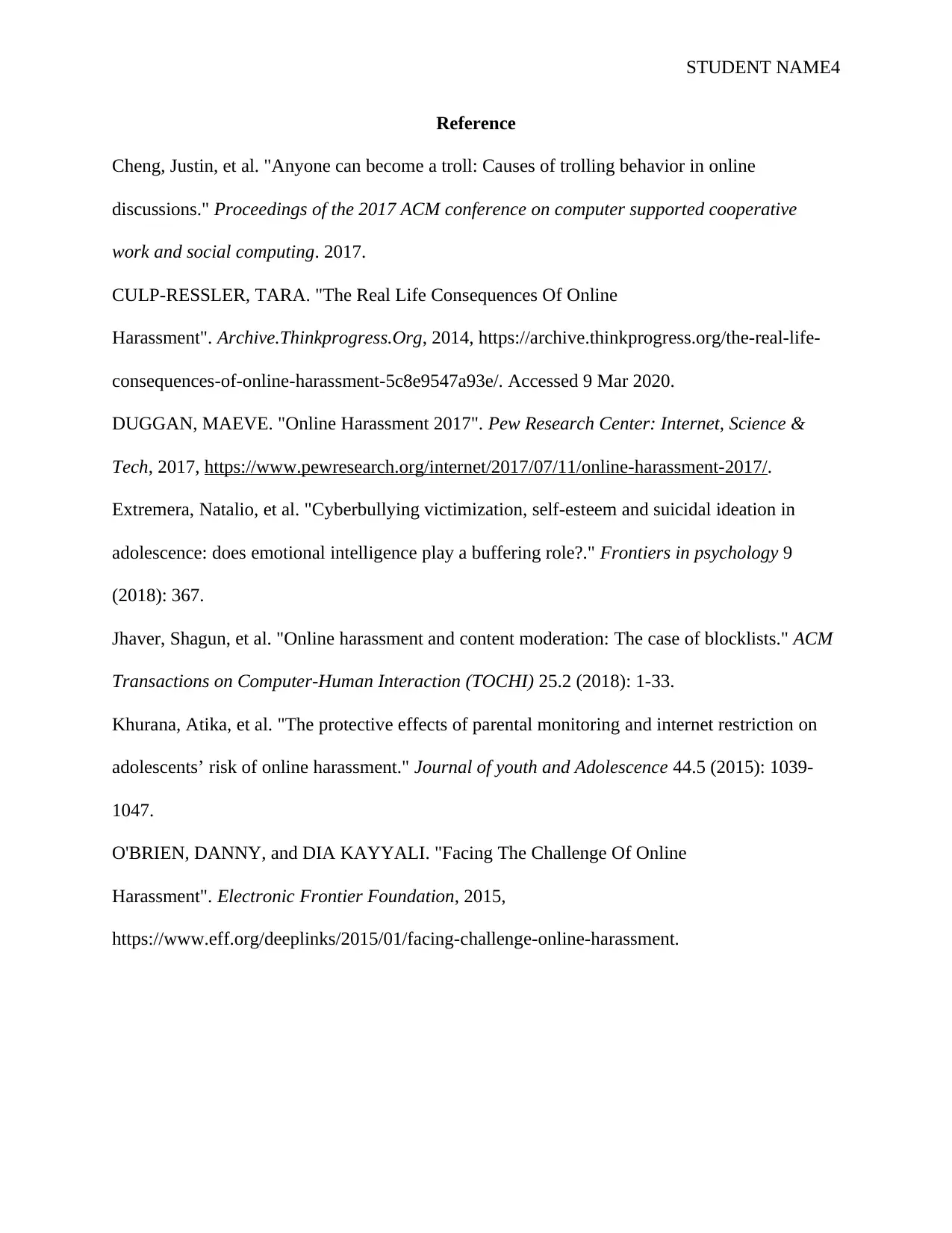A Detailed Analysis: Causes and Effects of Online Harassment
VerifiedAdded on 2022/08/20
|4
|1033
|40
Essay
AI Summary
This essay delves into the multifaceted issue of online harassment, examining its causes and profound effects on individuals and society. It begins by highlighting the shift in communication paradigms due to the internet's prominence, while acknowledging the emergence of online harassment as a significant challenge. The essay explores the causes of online harassment, including the role of social media, anonymity, and early access to technology. It also addresses the psychological and social challenges faced by victims, such as depression, anxiety, and social exclusion. Furthermore, the essay examines the various forms of online harassment, including insults, threats, and stalking, and discusses how these actions can lead to mental health issues and decreased self-esteem. The conclusion emphasizes the need for improved legal regulations and enforcement to combat online harassment and protect digital rights.

STUDENT NAME1
Student Name
Professor Name
Name of Course
Date
Causes and Effects of Online Harassement
Introduction
The internet prominence has shifted the paradigm on how individuals interact with one
another. The use of the internet has expanded worldwide, providing benefits to the entire world.
But, does all that glitter, has to be gold?” Along with the positive factors, the world of digital
media has developed a new culture of harassment. It freezes the users from several limitations
over communication as well as creativity which exist in the offline world (Jhaver et al. 12). This
paper aims to argue over the probable causes and effects of online harassment in the current
decade within society. It is also important to note that online harassment is one of those
challenges which can be stated as the issue related to digital rights.
Discussion
Causes of Online Harassment
It is to know that online harassment for cyberbullying has majorly been linked to
physical, social as well as psychological challenges for adolescent victims (Khurana et al. 1045).
According to Extreme et al. (367), bullying has a widespread impact on human interaction. The
causes of online harassment can be considered to be the use of instant messaging, social
networking websites which often threaten harasses or intimidate individuals. According to
research studies, online harassment is done by individuals who generally have early and
increasing access to social media and technologies (O'BRIEN and KAYYALI). The challenge of
Student Name
Professor Name
Name of Course
Date
Causes and Effects of Online Harassement
Introduction
The internet prominence has shifted the paradigm on how individuals interact with one
another. The use of the internet has expanded worldwide, providing benefits to the entire world.
But, does all that glitter, has to be gold?” Along with the positive factors, the world of digital
media has developed a new culture of harassment. It freezes the users from several limitations
over communication as well as creativity which exist in the offline world (Jhaver et al. 12). This
paper aims to argue over the probable causes and effects of online harassment in the current
decade within society. It is also important to note that online harassment is one of those
challenges which can be stated as the issue related to digital rights.
Discussion
Causes of Online Harassment
It is to know that online harassment for cyberbullying has majorly been linked to
physical, social as well as psychological challenges for adolescent victims (Khurana et al. 1045).
According to Extreme et al. (367), bullying has a widespread impact on human interaction. The
causes of online harassment can be considered to be the use of instant messaging, social
networking websites which often threaten harasses or intimidate individuals. According to
research studies, online harassment is done by individuals who generally have early and
increasing access to social media and technologies (O'BRIEN and KAYYALI). The challenge of
Paraphrase This Document
Need a fresh take? Get an instant paraphrase of this document with our AI Paraphraser

STUDENT NAME2
online harassment is also compounded by the fact that a bully can hide behind username while
disgusting his or her identity. This procedure of secrecy makes it very much difficult for tracing
the source which encourages bullies for behaving at an aggressive rate. Online harassment
includes actions like sending proactive insults, initiating crates, attempting towards infecting
resources of the victim, racial slurs and more. According to research data, 41% of the Americans
have been the target of online harassment as per the 2014 data report (CULP-RESSLER). Data
from research studies stated that one among 10 individuals receiving online harassment related to
physical threats. 6% of Americans have encountered sustained stalking and 7 % have been the
victim of online sexual harassment (Cheng et al. 1221). According to research data, online
harassment is specifically common for young adults. Americans among the age group of 18 to 29
years ( 47%) reported being called with offensive names in the online platform. More than 20%
of the adults reported having experienced online harassment due to their gender while a notable
proportion of 15% was harassed and stalked due to their ethnicity and race (DUGGAN). Further
data gathered from the survey highlighted that black community people also tend to encounter
online harassment at higher levels.
Effects of Online harassment
According to research studies, the effects of online harassment or cyberbullying are
linked to depression among young adults and teenagers. It has been found that adults who are
being targeted by cyberbullying tend to display negative reactions that are similar to those who
are the victims of traditional bullying. CULP-RESSLER in his research study argued the impact
of online harassment which is far more damaging than the traditional harassment since the
victims are not able to escape easily. Affected individuals tend to feel a prolonged sense of
victimization due to continuous online harassment and threats that lead to mental disorders
online harassment is also compounded by the fact that a bully can hide behind username while
disgusting his or her identity. This procedure of secrecy makes it very much difficult for tracing
the source which encourages bullies for behaving at an aggressive rate. Online harassment
includes actions like sending proactive insults, initiating crates, attempting towards infecting
resources of the victim, racial slurs and more. According to research data, 41% of the Americans
have been the target of online harassment as per the 2014 data report (CULP-RESSLER). Data
from research studies stated that one among 10 individuals receiving online harassment related to
physical threats. 6% of Americans have encountered sustained stalking and 7 % have been the
victim of online sexual harassment (Cheng et al. 1221). According to research data, online
harassment is specifically common for young adults. Americans among the age group of 18 to 29
years ( 47%) reported being called with offensive names in the online platform. More than 20%
of the adults reported having experienced online harassment due to their gender while a notable
proportion of 15% was harassed and stalked due to their ethnicity and race (DUGGAN). Further
data gathered from the survey highlighted that black community people also tend to encounter
online harassment at higher levels.
Effects of Online harassment
According to research studies, the effects of online harassment or cyberbullying are
linked to depression among young adults and teenagers. It has been found that adults who are
being targeted by cyberbullying tend to display negative reactions that are similar to those who
are the victims of traditional bullying. CULP-RESSLER in his research study argued the impact
of online harassment which is far more damaging than the traditional harassment since the
victims are not able to escape easily. Affected individuals tend to feel a prolonged sense of
victimization due to continuous online harassment and threats that lead to mental disorders

STUDENT NAME3
among them (Khurana et al. 1040). Overall reports explained that men and women tend to differ
modestly regarding the types and the categories of online harassment they encounter in the
online platform. 30% to 47% of men reported suffering from depression and anxiety due to the
effect of online harassment they have faced with offensive names and received physical online
threats. 34% of women as per the report by 2015 data stated how they felt social exclusion, a
constant fear of stalking and lower self-esteem, which are hampering their personal as well as
their professional lives.
Conclusion
Cyber Bullying or online harassment is linked to several multi adaptive psychological,
emotional as well as behavioral outcomes. Online harassment is a serious problem that can
profoundly damage the privacy rights and the freedom of speech of the targeted people. There
however lies several pitfalls regarding the legal regulation towards online harassment due to the
failure of enforcement and stronger regulations. These need to be improved for a better
tomorrow.
among them (Khurana et al. 1040). Overall reports explained that men and women tend to differ
modestly regarding the types and the categories of online harassment they encounter in the
online platform. 30% to 47% of men reported suffering from depression and anxiety due to the
effect of online harassment they have faced with offensive names and received physical online
threats. 34% of women as per the report by 2015 data stated how they felt social exclusion, a
constant fear of stalking and lower self-esteem, which are hampering their personal as well as
their professional lives.
Conclusion
Cyber Bullying or online harassment is linked to several multi adaptive psychological,
emotional as well as behavioral outcomes. Online harassment is a serious problem that can
profoundly damage the privacy rights and the freedom of speech of the targeted people. There
however lies several pitfalls regarding the legal regulation towards online harassment due to the
failure of enforcement and stronger regulations. These need to be improved for a better
tomorrow.
⊘ This is a preview!⊘
Do you want full access?
Subscribe today to unlock all pages.

Trusted by 1+ million students worldwide

STUDENT NAME4
Reference
Cheng, Justin, et al. "Anyone can become a troll: Causes of trolling behavior in online
discussions." Proceedings of the 2017 ACM conference on computer supported cooperative
work and social computing. 2017.
CULP-RESSLER, TARA. "The Real Life Consequences Of Online
Harassment". Archive.Thinkprogress.Org, 2014, https://archive.thinkprogress.org/the-real-life-
consequences-of-online-harassment-5c8e9547a93e/. Accessed 9 Mar 2020.
DUGGAN, MAEVE. "Online Harassment 2017". Pew Research Center: Internet, Science &
Tech, 2017, https://www.pewresearch.org/internet/2017/07/11/online-harassment-2017/.
Extremera, Natalio, et al. "Cyberbullying victimization, self-esteem and suicidal ideation in
adolescence: does emotional intelligence play a buffering role?." Frontiers in psychology 9
(2018): 367.
Jhaver, Shagun, et al. "Online harassment and content moderation: The case of blocklists." ACM
Transactions on Computer-Human Interaction (TOCHI) 25.2 (2018): 1-33.
Khurana, Atika, et al. "The protective effects of parental monitoring and internet restriction on
adolescents’ risk of online harassment." Journal of youth and Adolescence 44.5 (2015): 1039-
1047.
O'BRIEN, DANNY, and DIA KAYYALI. "Facing The Challenge Of Online
Harassment". Electronic Frontier Foundation, 2015,
https://www.eff.org/deeplinks/2015/01/facing-challenge-online-harassment.
Reference
Cheng, Justin, et al. "Anyone can become a troll: Causes of trolling behavior in online
discussions." Proceedings of the 2017 ACM conference on computer supported cooperative
work and social computing. 2017.
CULP-RESSLER, TARA. "The Real Life Consequences Of Online
Harassment". Archive.Thinkprogress.Org, 2014, https://archive.thinkprogress.org/the-real-life-
consequences-of-online-harassment-5c8e9547a93e/. Accessed 9 Mar 2020.
DUGGAN, MAEVE. "Online Harassment 2017". Pew Research Center: Internet, Science &
Tech, 2017, https://www.pewresearch.org/internet/2017/07/11/online-harassment-2017/.
Extremera, Natalio, et al. "Cyberbullying victimization, self-esteem and suicidal ideation in
adolescence: does emotional intelligence play a buffering role?." Frontiers in psychology 9
(2018): 367.
Jhaver, Shagun, et al. "Online harassment and content moderation: The case of blocklists." ACM
Transactions on Computer-Human Interaction (TOCHI) 25.2 (2018): 1-33.
Khurana, Atika, et al. "The protective effects of parental monitoring and internet restriction on
adolescents’ risk of online harassment." Journal of youth and Adolescence 44.5 (2015): 1039-
1047.
O'BRIEN, DANNY, and DIA KAYYALI. "Facing The Challenge Of Online
Harassment". Electronic Frontier Foundation, 2015,
https://www.eff.org/deeplinks/2015/01/facing-challenge-online-harassment.
1 out of 4
Related Documents
Your All-in-One AI-Powered Toolkit for Academic Success.
+13062052269
info@desklib.com
Available 24*7 on WhatsApp / Email
![[object Object]](/_next/static/media/star-bottom.7253800d.svg)
Unlock your academic potential
Copyright © 2020–2025 A2Z Services. All Rights Reserved. Developed and managed by ZUCOL.




